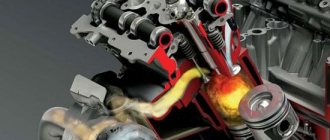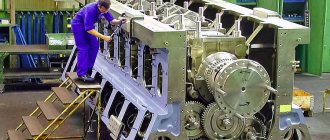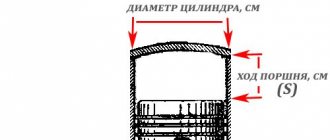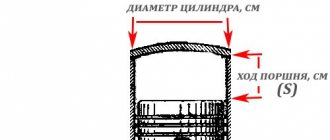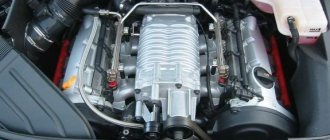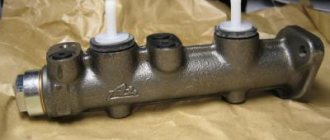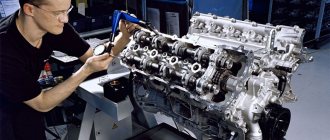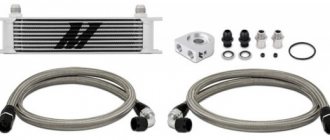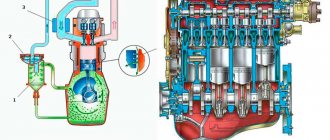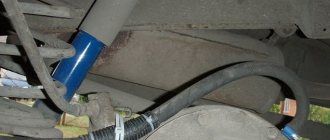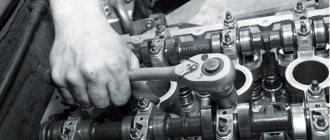One of the most important characteristics of any gasoline or diesel engine is its displacement. Since the appearance of the first internal combustion engines, this characteristic of the engine has been the primary indicator by which one or another power unit is distinguished. For this reason, the concept of “engine displacement” is constantly used in relation to various power plants. On many cars, the engine size is indicated in the form of a special nameplate next to the designation of the model itself. For example, BMW 740 means that it is the seventh series in the model range with an engine capacity of 4.0 liters.
The power characteristics, maximum vehicle speed, etc. greatly depend on the working volume of an atmospheric or turbocharged engine. Moreover, the division of cars into classes, the formation of taxation and the determination of the amount of payment of various fees also takes into account the type of engines and volumes that are installed by the manufacturer for different models/types of vehicles and other vehicles. It should be noted that many consumers are not always well aware of what engine displacement actually is. Next, we intend to talk about what makes up the working volume of an internal combustion engine, how to find out the engine size, etc.
What is engine displacement
An internal combustion heat engine is an impressive complex of various mechanisms, systems and additional attachments, forming a complex engineering solution. The general principle of operation of an internal combustion engine involves supplying fuel and air to a special closed chamber, where the resulting fuel-air mixture ignites. As a result of fuel combustion, energy is released, which pushes the piston located in the engine cylinder. The piston moves, the crankshaft converts the reciprocating motion of the piston into rotational motion, which allows the crankshaft to rotate. Next, the engine torque is transmitted to the transmission and then to the drive wheels of the car. This process is constantly repeated after starting the engine, that is, the engine is running all the time, provided that the components are supplied and the fuel mixture is efficiently burned in the working chamber. This chamber is called the combustion chamber. The volume of the combustion chamber (also known as the working volume) is the product of the cross-sectional area of the cylinder and the length of the piston stroke from BDC to TDC (top and bottom dead center of the piston stroke). The physical volume of the combustion chamber is the working volume of the engine in gasoline and diesel cars, motorcycles and other types of land, air or water transport, agricultural machinery, as well as other mechanisms and devices using internal combustion engines. Please note that if the engine has several cylinders, then the volume of the combustion chamber in each of them must be summed up with the others. In other words, the working volume of a multi-cylinder engine is the sum of the volume of the combustion chambers of all cylinders of such an engine. The total volume of all engine cylinders is usually expressed in liters. The working volume of the combustion chamber is indicated in cubic centimeters.
General provisions
To understand how the parameter in question can affect the characteristics of the vehicle, it is important to know the design of the internal combustion engine.
In short, the engine consists of the following elements:
- Cylinder block;
- Block heads;
- Combustion chambers;
- A piston, which is combined with the crankshaft through a crankshaft;
- Fuel mixture supply and ignition system;
- Valves through which combustion products (exhaust gases) are discharged;
- Carter.
Classification of cars by engine size
As a rule, in the model range of each manufacturer there are more and less powerful cars that differ in size and weight. Small-sized cars, such as the Daewoo Matiz, are not equipped with large-volume engines, since an engine with a displacement of 1.0 is sufficient for this small and light car to achieve decent dynamic characteristics. Accordingly, Daewoo Matiz belongs to the class of minicars, and the heavy crossover BMW X5 with an engine capacity (in one of the modifications) of 4.6 liters belongs to the class of large cars. Between these “extremes” are small and medium-sized cars. By the way, in some cases there is no direct relationship between the working volume and its dimensions and weight. A good example is sports cars and supercars. The Lamborghini Gallardo engine capacity is 5 liters and weighs 1.5 tons. The recently published list of cars subject to the “luxury tax” does not include models with an engine capacity of less than three liters. Other parameters of the car also depend on the engine size. First of all, power. The more fuel is burned in one cycle in the engine cylinders, the more energy is released. The acceleration of the car and its maximum speed directly depend on the engine power. We should not forget about the existence of an inverse relationship: the larger the displacement, the higher the fuel consumption.
see also
Engine stalls when cold
- 8 0 2k
Wear of liners
- 41 1 48k
Valve cover and cylinder head sealant
- 77 2 107k
Blue smoke from the exhaust
- 86 0 57k
Interactive engine cooling system diagram
- 66 0 107k
The working volume of the cylinder is the volume located between the extreme positions of the piston movement.
The formula for calculating a cylinder has been known since school curriculum - the volume is equal to the product of the area of the base and the height. And in order to calculate the engine volume of a car or motorcycle, you also need to use these multipliers. The working volume of any engine cylinder is calculated as follows:
Is it possible to increase the engine size?
This question is often asked by car owners who want to increase power. There is such a possibility, but it will not be possible to significantly increase the volume. The volume is increased during an engine overhaul, since to restore the shape of the cylinder walls they have to be bored on a special machine (unless, of course, liners are used in it). The cylinder walls are slowly but steadily ground down from constant friction, which leads to an increase in the volume of the combustion chamber, and boring only helps restore the damaged geometry and correct the discrepancy in the volume of different cylinders. In Japan, the class of small cars is “kei car” with an engine capacity of up to 660 cc. exempt from road tax The ability to increase volume is limited by the fact that manufacturers believe that major overhauls are only justified three times, after which the engine must be scrapped. After boring the block, each time you have to buy new pistons of larger diameter, which are called “repair”. There are only three calibers of repair pistons. In this regard, replacing the engine with the same one, but initially having a larger volume, is a much more promising activity in terms of increasing power.
We give a definition
Engine volume is measured not in liters, but in cubic centimeters. Even those who are far from cars and just heard about it from familiar drivers know about this. However, for most, this figure means absolutely nothing, which is a rather sad fact.
Nevertheless, automakers and experts have long introduced a special classification of internal combustion engines by volume. This allows, practically without looking at the documentation, to find out the real potential of the machine and draw conclusions about how much it is worth the money.
What does engine volume mean, and what does this value affect? To answer this question, it is worth remembering how a modern internal combustion engine works, and what causes the movement of its components and mechanisms. The fact is that the engine has several cylinders in which movable pistons are located. A mixture of gasoline vapor and air is injected under pressure into the cylinders. As soon as the mixture enters the cylinders, it is ignited using spark plugs, and the piston moves up or down as the burning mixture expands.
The working volume of a car engine is measured in cubic centimeters, and this is not the volume of the injected mixture. This is the total volume of the combustion chambers.
What does this affect? Based on this figure, several conclusions can be drawn at once, which may seem obvious to many.
OPTIMUM DISPLACEMENT
Almost all manufacturers offer several engines for the same car model, and choosing the optimal engine is not always easy. Conventionally, cars are divided into several classes:
- minicars, with an engine capacity of no more than 1100 cubic meters. cm;
- small-capacity, with a volume of 1200 - 1700 cubic meters. cm;
- mid-displacement, with a volume of 1800 - 3500 cubic meters. cm;
- large-capacity, with a volume of more than 3500 cubic meters. cm.
There is a gradation of power units by car class. For class B cars, engines from 1.0 to 1.6 liters are usually offered, C-class is equipped with engines with a volume of 1.4 to 2 liters, D-class - 1.6 - 2.5 liters, E-class - from 2 liters When choosing a suitable engine for himself, the future car owner must determine in what conditions the car will be primarily used. For driving in urban conditions, a motor with a smaller displacement (for example, 1.4 liters) is quite suitable if it has good traction at low speeds. If there is insufficient traction at the bottom, the engine will have to be constantly “twisted”, and you can forget about the promised eight liters of fuel per 100 km in the city.
It is also necessary to take into account that the switched on air conditioning system takes up a significant part of the power and increases fuel consumption. In this case, driving a car with a low-power engine becomes unpleasant, since the driver will constantly be forced to engage lower gears.
If the car will primarily be used on the highway, it is better to choose a larger engine.
- Firstly, the difference in consumption will not be so significant;
- secondly, under the hood of the car there will always be a reserve of power, which will allow the driver to overtake more confidently;
- In addition, turning on the air conditioning or climate control system has virtually no effect on the dynamics of the car.
Expertise in MREO or specialized car service
If you yourself were unable to find out the car’s engine number, or you have any suspicions about the veracity of the seller’s words, you should contact the experts at MREO. In the process of full technical examination and diagnostics. But this check will last about 2 days and does not always give a positive result. Plus, you need to handle the seller and the car together, which is quite energy-consuming and often scares off even those car owners who sell the car on completely legal terms.
Another way is to contact a car service center, where specialists, using methodological literature and instructions from the manufacturer, will determine the engine model. The only but big minus is that this service will cost between 500-2500 rubles. Plus, checking the engine of a used car is not always possible. If some of the characters are erased, then even specialists will find it difficult to read the number. There is also a risk that the seller will pay a car service worker to indicate the wrong engine number.
Features of operation of large cars
Compared to small-displacement engines, large-displacement engines are characterized by smoother operation and less noticeable wear, since they are much less likely to have to operate at the power limit. An engine with a large combustion chamber produces its maximum capabilities only when it participates in racing, i.e. in sports competitions. When driving in normal mode, the engine retains a reserve of power, so it does not wear out. Fuel consumption, of course, remains higher than that of small-displacement engines, but it can be reduced by properly adjusting the gearbox. A powerful engine, which is rarely used in hard conditions, is capable of driving up to a million kilometers without the need for major repairs. Therefore, the costs incurred when purchasing a powerful large car are subsequently recouped by the long-term operation of the car.
What does engine size affect?
Firstly, gasoline consumption. The larger the cylinder volume, the more fuel is needed to ignite it with maximum efficiency, and accordingly, consumption increases. However, this minus turns into an equally tangible plus. The larger the engine displacement, the greater the engine power, since more gasoline releases more energy.
Secondly, as already noted, the larger the volume, the greater the power, that is, a car with a larger engine will accelerate faster, be able to carry heavier loads and more passengers. Often, larger engines turn out to be much more economical: there is no need to press the gas pedal hard to accelerate the car. Fuel consumption does not increase, while small engines burn much more fuel under load. The larger the volume, the larger the engine itself, the larger the car. Let's put it this way: large volumes are used on higher-class cars, which is why the engine and all other systems are more expensive to maintain. The price for such a car is obviously higher. In order to understand which car is best for you, you should understand that micro and small cars are best suited for driving in large cities with traffic jams. Their consumption in city traffic will be minimal compared to other cars, but, in turn, such cars are not suitable for long journeys, since at speeds over 100 km/h they clearly do not have enough power. They will also not be able to transport a lot of cargo.
Cars with a volume of 1.8 to 3 liters are excellent for both city traffic and long trips; their power is enough for acceleration and driving at high speed, for transporting goods, and the gas mileage of such cars is not that great.
Cars equipped with engines of 3 liters or more are either SUVs or minibuses and minivans designed to carry more passengers or cargo.
